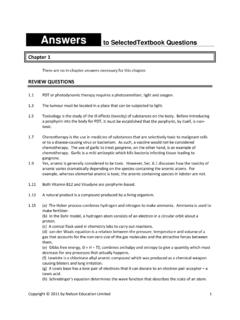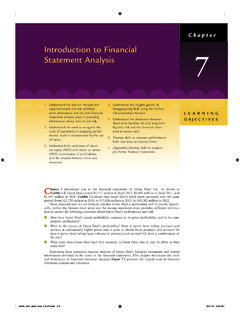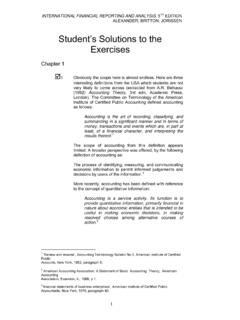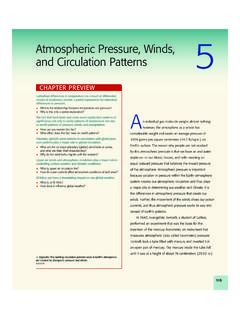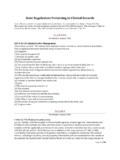Transcription of Clinical Treatment Plans - Cengage
1 Clinical Treatment Plans 89 Gehart Chapter 4 02/20/2009 Clinical Treatment PlansClinical Treatment Plans provide a straightforward, comprehensive overview of treat - ment . They include the following parts:Introduction: Defi nes who is being treated, if medications are being used, and what contextual factors were considered in creating a plan that is sensitive to client Tasks: Describes Treatment tasks that the therapist should perform at the initial, working, and closing phases of therapy. These tasks are informed by theory as well as ethical and legal Goals: Determines what goals are unique to each client and what behaviors, thoughts, feelings, or interactions will be either increased or decreased as a result of Treatment .
2 Client goals are derived from the assessment of the presenting prob-lem and are stated in theory-specifi c : Describes, for each goal, two to three interventions for achieving this goal using the therapist s chosen Perspective: Describes areas of client agreement and concern with the outlined is the general Treatment plan format. In this form, TT refers to therapeutic task, and I refers to intervention. Treatment PLANT herapist: Client ID #: Theory: Primary Confi guration: Individual Couple Family Group Additional: Individual Couple Family Group: Medication(s): NA Contextual Factors considered in making plan : Age Gender Family dynamics Culture Language Religion Economic Immigration Sexual orientation Trauma Dual dx/comorbid Addiction Cognitive ability Other: Describe how plan is adapted to contextual factors: I.
3 Initial Phase of Treatment (First 1 3 Sessions) Initial Therapeutic Tasks Therapeutic Relationship TT1: Develop therapeutic relationship with all members. Note: I1: Intervention: (continued) 892/20/09 8:34:04 PM2/20/09 8:34:04 PM90 CHAPTER 4 Treatment PlanningGehart Chapter 4 02/20/2009I. Initial Phase of Treatment (First 1 3 Sessions) Initial Therapeutic Tasks Assessment TT2: Assess individual, system, and broader cultural dynamics. Note: I1: Intervention: I2: Intervention: Goals TT3: Defi ne and obtain client agreement on Treatment goals. Note: I1: Intervention: Referrals and Crisis TT4: Identify needed referrals, crisis issues, and other client needs. Note: I1: Intervention: Initial Client Goals (1 2 Goals): Manage crisis issues and/or reduce most distressing #1: Increase Decrease (personal/relational dynamic) to reduce (symptom).
4 Measure: Able to sustain for period of wks mos with no more than mild episodes of . I1: Intervention: I2: Intervention: II. Working Phase of Treatment (Sessions 2+) Working Therapeutic TasksMonitor Progress TT1: Monitor progress toward goals. Note: I1: Intervention: Monitor RelationshipTT2: Monitor quality of therapeutic alliance as therapy proceeds. Note: I1: Intervention: Working Client Goals (2 3 Goals): Target individual and relational dynamics in case con-ceptualization using theoretical language ( , reduce enmeshment, increase differentiation, increase agency in relational narrative, etc.). (continued) 902/20/09 8:34:05 PM2/20/09 8:34:05 PM Clinical Treatment Plans 91 Gehart Chapter 4 02/20/2009 Goal #1: Increase Decrease (personal/relational dynamic) to reduce (symptom).
5 Measure: Able to sustain for period of wks mos with no more than mild episodes of . I1: Intervention: I2: Intervention: Goal #2: Increase Decrease (personal/relational dynamic) to reduce (symptom).Measure: Able to sustain for period of wks mos with no more than mild episodes of . I1: Intervention: I2: Intervention: Goal #3: Increase Decrease (personal/relational dynamic) to reduce (symptom).Measure: Able to sustain for period of wks mos with no more than mild episodes of.
6 I1: Intervention: I2: Intervention: III. Closing Phase of Treatment (Last 2+ Weeks) Closing Therapeutic TasksTermination plan TT1: Develop aftercare plan and maintain gains. Note: I1: Intervention: Closing Client Goals: Determined by theory s defi nition of #1: Increase Decrease (personal/relational dynamic) to reduce (symptom).Measure: Able to sustain for period of wks mos with no more than mild episodes of . I1: Intervention: I2: Intervention: (continued) 912/20/09 8:34:05 PM2/20/09 8:34:05 PM92 CHAPTER 4 Treatment PlanningGehart Chapter 4 02/20/2009 Writing Useful Therapeutic TasksTherapeutic tasks are generally the easiest part of the Treatment plan to develop because they are the most formulaic.
7 Each theory has its own language and interven-tions for describing how to create a therapeutic relationship, and a good plan should refl ect these differences. For example, a Bowen intergenerational therapist focuses on remaining nonreactive to clients, whereas a therapist using experiential family ther-apy has a more emotionally engaged approach to creating a therapeutic PhasePerhaps not surprisingly, therapists have the most tasks in the initial phase of treat - ment because this is when they establish the foundation for therapy. Virtually all theories include four therapeutic tasks (TTs) early in therapy, as shown in the form already presented:TT1: Establish a therapeutic relationshipTT2: Assess individual, family, and social dynamicsTT3: Develop Treatment goalsTT4: Case management: refer for medical/psychiatric evaluation; connect with needed community resources; rule out substance abuse, violence, and medical issuesAlthough each theoretical approach has different ways to do these four things, the cross-theory similarities make it easy for therapists to conceptualize this early phase of Treatment .
8 If problems arise in Treatment , therapists can be sure that one of these four initial tasks needs to be PhaseIn the working phase, the primary task is to keep the ball rolling. As therapy pro-gresses, therapists need to assess whether Treatment is effective. Is the client making progress on the identifi ed goals? If not, what might be the reason, and how can therapy be adjusted to accomplish those goals? Family therapists rarely cite resistance as a valid reason for lack of progress. Steve de Shazer (1984) declared the death of resis-tance, implying that lack of progress cannot be blamed on the client. If initial inter-ventions don t work, the therapist does not need to blame clients or himself/herself and instead should simply focus on fi guring out what does work.
9 Similarly, systemic therapists have consistently admonished that, if clients are not progressing, the thera-pist has not yet developed a useful working hypothesis or found a way to usefully deliver it to clients (Selvini Palazzoli, Boscolo, Cecchin, & Prata, 1978; Watzlawick, Weakland, & Fisch, 1974). In the systemic approach, each failed intervention tells the therapist what doesn t work and therefore provides clues as to what might Client PerspectiveHas Treatment plan been reviewed with client? Yes No; If no, explain: Describe areas of client agreement and concern: 2007. Diane R. Gehart(continued) 922/20/09 8:34:06 PM2/20/09 8:34:06 PM

